Carrier (1999) (30 page)
Authors: Tom - Nf Clancy

Finally, N880 took a leadership position with the other services on a new generation of precision-strike weapons. These would be guided to their targets by GPS navigation systems, and then given final guidance by a new family of self-locking, all-weather seeker systems.
By the time he retired in early 1998, Chuck Nash had done more for Naval aviation as a captain than most admirals. As a result of the programs inspired by the likes of Jay Johnson, Dennis McGinn, “Carlos” Johnson, Chuck Nash, and
many
others, there is now real hope and drive in naval aviation. A new air wing structure has been defined, and plans for aircraft procurement are now clear for the next quarter century.
many
others, there is now real hope and drive in naval aviation. A new air wing structure has been defined, and plans for aircraft procurement are now clear for the next quarter century.
Today the climate in the fleet and naval aviation program offices is very different. Much like their counterparts at NAVSEA, the leaders at the Naval Air Systems Command (NAVAIR) are now looking toward the future rather than back toward the past. Their goal is to produce the aircraft and weapons that will fly off the new generation of carriers that are due in the middle of the second decade of the next century. For the first time in a generation, Naval aviation leaders are not content to run programs and buy updated versions of old aircraft and weapons. Naval aviation’s vision is now on the cutting edge of weapons technology.
To this end, a new aircraft, the F/A-18E/F Super Hornet, is being tested and headed into the fleet, while existing aircraft like the F-14 Tomcat, EA-6B Prowler, and S-3B Viking have been modified to take on new roles and missions. These will help maintain the credibility of naval aviation until the new aircraft types arrive in a few years. New weapons, with greater precision and utility than those used in Desert Storm, are on their way as well. The sea services, along with the other branches of the U.S. military, are in the early stages of developing the replacement for today’s aircraft through the new JSF program. There are even visionary studies for the first generation of Unmanned Aerial Combat Vehicles (UCAVs), which will likely be seen in ten to twenty years. What a difference just a few years make!
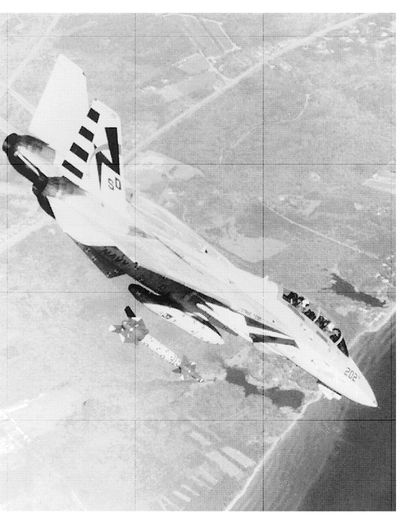
An F-14 Tomcat delivering a GBU-24 Paveway III laser-guided bomb during tests. The addition of new air-to-ground strike systems have turned the Tomcat into a potent fighter bomber.
RAYTHEON STRIKE SYSTEMS
The Plan: Naval Aviation in the 21st CenturyThe plan for naval aviation as it heads into the 21st century is designed to take carrier aviation from the current post-Cold War CVW structure to one that reflects the perceived needs of the Navy in 2015. To do this, NAVAIR has put together a three-stage program of procurement and reorganization that relies heavily on the success of the past—and that learns from the mistakes that were made. Back in the early 1970’s, the so-called “CV Air Wing” organization was created to reduce the number of carriers and air groups in the fleet. This type of CVW was an all-purpose unit, with capabilities in antiair warfare (AAW), antisubmarine warfare (ASW), antisurface warfare (ASUW), and land attack. Its structure is laid out below:
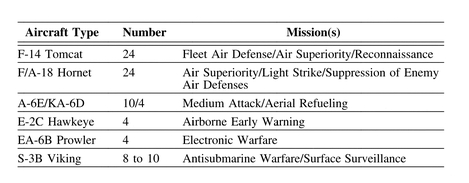
Aircraft parked on the busy flight deck of the USS
George Washington
(CVN-73). Efficient deck handling of aircraft can make or break the daily air tasking order of a battle group.
George Washington
(CVN-73). Efficient deck handling of aircraft can make or break the daily air tasking order of a battle group.
JOHN D. GRESHAM
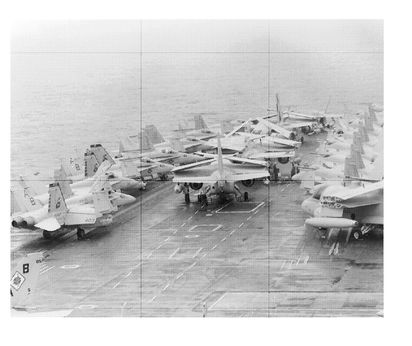

As the table shows, the “CV” air wing had a primary emphasis on defense against air and submarine attack. It could also dish out a great deal of punishment against enemy naval forces, though its ability to strike land targets was more limited. It was this air wing structure that John Lehman tried to flesh out with his aircraft procurement plan in the 1980’s. But because of the fallout from the A-12 fiasco, the aircraft necessary to fill out sixteen such units were never purchased, and the fleet made frequent draws on Marine F/A-18 Hornet and EA-6B Prowler squadrons in order to sustain the heavy deployment schedule of the late Cold War years.
After the end of the Cold War, the following air wing organization was created, and is in use today around the fleet:
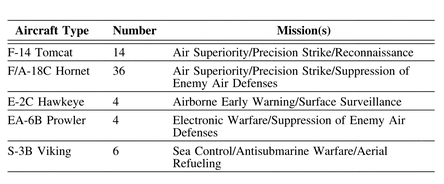

This CVW structure reflects a number of realities, most importantly the fact that there will only be eleven CVWs (ten active-duty and one reserve) for twelve carriers, greatly reducing the number of new aircraft required to sustain carrier aviation into the 21st century. Also, this 1990’s CVW has a new orientation: to project precision-striking power onto targets ashore. Both the F-14’s and F/A-18’s are equipped with precision-targeting and reconnaissance systems, as well as a wide variety of Desert Storm-era PGMs. All of these systems give the new CVWs much more punch than before, and while the number of fighter/attack aircraft has been greatly reduced, this new air wing actually can strike twice the number of precision targets that a Cold War CVW could hit. It will acquire even greater power when the new generation of GPS-guided PGMs arrives over the next few years.
The next big move will occur in the early years of the 21 st century. Starting somewhere around 2001, the Navy will commission its first combat squadron of F/A-18E/F Super Hornets, replacing the F-14 Tomcat squadron in CVWs. The Navy will then be able to rapidly retire the elderly F-14As, some of which will be over three decades old when they head to the boneyard. During this same period, the SH-60B/F and HH-60G fleet will be remanufactured into a common variant known as the SH-60R. The surviving H-60 airframes will then be consolidated into a single version that can be used either on carriers or escorts. The Navy will also buy a number of CH-60 airframes, which will take over from the old UH-46 Sea Knight in the Vertical Replenishment (VERTREP) mission aboard supply ships, as well as the special operations/combat search and rescue (SO/CSAR) mission of the HH-60G.
Despite all these changes, the dominant airframe of this air wing will continue to be late-model F/A-18C Hornets, which will soldier on well into the 21st century. With these changes, the typical CVW of 2001 to 2015 will probably look like this:

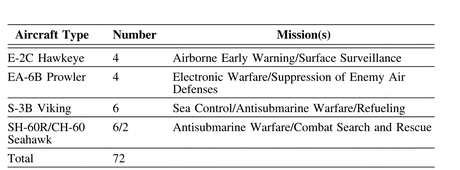
Again, the key attribute of this CVW will be striking power against land-based precision targets. However, with a new generation of self-designating, GPS/INS-guided PGMs, it will be able to dish out truly devastating damage to targets afloat or ashore, and in almost any kind of weather.
Other books
Gates of Dawn by Susan Barrie
A Gentle Hell by Christian, Autumn
Powers by Deborah Lynn Jacobs
Hijacked (A Retribution Novel) by Stark, Cindy
Taken by Barbara Freethy
Heart of the Warrior by Lynne, Donya
Leader of the Pack by Lynn Richards
The Pussy Pounders Volume 1 ( A Novella ) by Candace Mumford
To Ride the Gods’ Own Stallion by Diane Lee Wilson
Sweet Surrender (Sweet Jealousy, Book Two) by Garrity, Morgan
